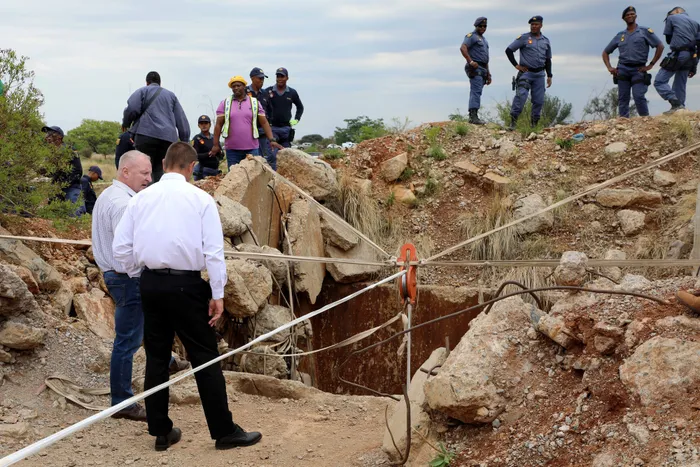
The police inspect the Stilfontein mine, in the North West Province, where illegal mining is rife. Armed criminal syndicates frequently control zama zama operations, leading to an increase in violent crime, including gunfights, turf wars, and attacks on law enforcement.
Image: Timothy Bernard / Independent Newspapers
Illegal mining, driven by zama zamas — illegal or artisanal miners who exploit abandoned or active mines — has become one of the most urgent threats to South Africa’s public safety, national security, and economic stability.
With thousands of miners working in secret underground shafts, the illicit activity is fueling crime, endangering communities, and severely damaging the environment.
The severity of the crisis was underscored in a recent raid at Sheba Gold Mine in Barberton, where nearly 500 illegal miners were arrested during Operation Vala Umgodi, a government initiative aimed at cracking down on illegal mining.
Authorities believe more than 1,000 zama zamas were operating in the mine before the operation began. Roughly 400 are still believed to be underground, resisting law enforcement efforts to bring them to the surface.
But Sheba is not an isolated case. Illegal mining is widespread across South Africa, particularly in areas rich in gold, platinum, and other minerals. Known hotspots include Dooronkop Mine near Slovoville in Soweto, Randfontein, Krugersdorp, Barberton, Rustenburg, Welkom, Carletonville, the East Rand, and Bloemfontein in the Free State.
Smaller towns like Vaal Reef and Witbank have also reported growing illegal mining activity. Mining experts estimate that more than 120 000 zama zamas are currently operating across the country. Many work in disused or abandoned mines, where law enforcement presence is minimal, and entry points are largely unsecured.
These makeshift mining operations are not only illegal but also extremely dangerous—miners often dig without proper equipment, safety gear, or ventilation, leading to frequent tunnel collapses and deaths.
A National Crisis Posing Grave Risks
The risks posed by illegal mining extend far beyond those underground. Armed criminal syndicates frequently control zama zama operations, leading to an increase in violent crime, including gunfights, turf wars, and attacks on law enforcement.
Police report that many of these groups are heavily armed and deeply embedded in local communities, making enforcement both dangerous and complex. Illegal miners themselves are often victims of exploitation.
Many are undocumented foreign nationals who are recruited or forced into the mines by crime networks. They work under harsh conditions for minimal or no pay, with no legal protections or recourse. Injuries and fatalities are common, and the bodies of deceased miners are frequently abandoned underground.
The environmental toll is equally severe. Illegal mining operations typically use mercury and other harmful chemicals to extract gold, polluting nearby rivers and groundwater. Waste is dumped indiscriminately, causing soil erosion, vegetation loss, and long-term health risks to residents living near mining areas. In some regions, water sources once used for drinking and farming are now contaminated beyond recovery.
Government Response and Community Impact
In response, the South African government has stepped up operations through initiatives like Operation Vala Umgodi and proposed reforms under the National Mining Safety Act.
The Department of Mineral Resources and Energy has also pledged to formalise parts of the small-scale mining sector in a bid to offer legal pathways and reduce the appeal of illegal operations.
However, enforcement remains inconsistent, and progress is slow.
Local police forces, especially in smaller towns, are often under-resourced and overwhelmed. Community leaders say zama zamas return shortly after raids end, reoccupying mines and continuing operations.
Residents are caught in the crossfire, living in fear of armed groups and suffering from the collapse of local infrastructure, contaminated environments, and rising crime.
Barberton, with its deep historical ties to gold mining, has become a flashpoint in the fight against illegal operations.
Local officials have called for broader solutions that address the root causes of illegal mining—unemployment, poverty, and lack of economic opportunity. Community groups are urging government investment in legal mining initiatives, job creation programs, and stronger cross-border enforcement to curb the flow of undocumented miners.
Without decisive, coordinated action, the threat posed by the estimated 120,000 zama zamas operating across South Africa is likely to intensify — further endangering lives, crippling ecosystems, and undermining lawful mining operations that contribute to the national economy.